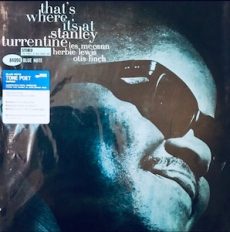
Requisites
That’s Where It’s At ~ Stanley Turrentine | By Eddie Carter
Stanley Turrentine was an exceptionally prolific tenor saxophonist who garnered numerous admirers throughout his career. He is widely recognized as a key contributor to the evolution of blues-inspired hard bop and soul jazz, as well as a trailblazer in smooth jazz. This morning’s featured album submitted for your approval is a 1962 release, That’s Where It’s At (Blue Note BLP 4096/BST 84096). This record was his second collaboration with pianist Les McCann and bassist Herbie Lewis, coming on the heels of their live performance at the Village Gate just a week prior. Drummer Otis Finch completes this dynamic quartet. The copy in my library is the 2020 Blue Note Tone Poet Series stereo reissue, which maintains the original catalog number.
The album opener, Smile, Stacey by Les McCann, begins with a brief dialogue between Stanley and Les that leads into the foursome’s theme. Stanley takes charge first, delivering a driving energy and brisk articulation. Les then swings in for the second interpretation. Herbie takes a short, sharply executed walk next, which Les finishes, then
Stanley and Les share a brief exchange with Otis before the ensemble’s soft fadeout. The quartet then cools down for Soft Pedal Blues by Stanley Turrentine, which starts with the trio’s slow-burning, soulful intro. Turrentine’s notes are placed with thoughtful precision during the melody and opening statement. McCann caresses each note of the second solo, and Turrentine delicately shapes a final comment into the theme’s restatement and slow fade.
Pia by Les McCann begins with the quartet easing into a mellow groove as the melody is introduced. Les initiates the solos with some good down-home cooking. Stanley steps in next, maintaining the calm atmosphere with a thoughtful message before the ensemble reunites for the closing chorus, which gently fades away. We’ll See Yaw’ll After While, Ya Heah by Les McCann is the pianist’s lively composition with a distinctly Southern flavor. After the quartet’s theme gets things off to a good start, Turrentine leads off the first solo, delivering each verse with precise articulation. McCann responds with a spirited interpretation that gets listeners tapping their feet and grinning along until the group’s return for the ending theme.
The tempo slows down again for Dorene, Don’t Cry, I, by Les McCann, a haunting ballad that begins with the ensemble’s beautiful melody. Stanley fully embraces the opening statement by gently attending to every note with careful lyricism and sensitivity. Les follows with something significant to say in a gorgeous performance preceding the tender reprise and close. Light Blue, by Stanley’s brother, Tommy Turrentine, brings this entertaining album to a close with a lightly swinging melody that invites listeners to sit back and enjoy the ride. McCann takes the lead with a loose, relaxed reading, then Lewis provides a few moments of pure joy. Turrentine offers the final memorable moment ahead of the group’s out chorus.
Alfred Lion produced the initial session of That’s Where It’s At, and Rudy Van Gelder was behind the dials of the recording. Joe Harley supervised the audiophile reissue, and Kevin Gray mastered the album from the original analog tapes at Cohearant Audio. The album’s sound quality is outstanding, with a stunning soundstage that transports the musicians to the sweet spot in your listening room with superb fidelity. The record was pressed on 180-gram Virgin Vinyl at RTI and is dead silent until the music begins. You’re also getting high-definition gatefold photos and superb cover packaging worthy of hanging on the wall. If you’re already a member of the Stanley Turrentine or Les McCann fan club, I highly recommend That’s Where It’s At on your next record hunt. If you aren’t already familiar with either musician, this record is an excellent introduction to their extensive discographies!
~ Les McCann Ltd. In New York (Pacific Jazz PJ-45/ST 45) – Source: Discogs.com © 2025 by Edward Thomas Carter
More Posts: choice,classic,collectible,collector,history,instrumental,jazz,music,saxophone
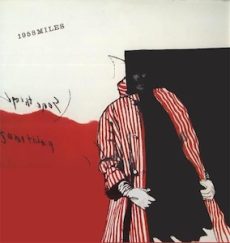
Requisites
1958 Miles ~ Miles Davis | By Eddie Carter
Throughout his career, Miles Davis was widely regarded not only as a leading figure in jazz but as a monumental presence in music as a whole. He consistently demonstrated his influence by producing an impressive array of records that have remained influential over the years, offering critics, listeners, and fellow musicians more to consider and appreciate than most artists across any musical style. This morning’s album up for discussion is 1958 Miles (CBS/Sony 20AP 1401). Interestingly, this record did not see a complete release in Japan until 1974. Tracks: A1 to A3 were initially released on “Jazz Track” in 1958. Track B1 later appeared on the 1975 double album “Black Giants, ”while track B2 appeared twice in 1973, on the compilations “Basic Miles—The Classic Performances of Miles Davis” and the CBS/Sony Japanese release “The Miles Davis Quintet & Sextet.”
By the time he recorded this album, Davis had brought in some new talented musicians to his group. Red Garland and “Philly” Joe Jones had left, and in their places, pianist Bill Evans and drummer Jimmy Cobb joined the band. Rounding out the ensemble are Julian “Cannonball” Adderley on alto sax (tracks: A1, A2, B1), John Coltrane on tenor saxophone (tracks: A1 to B2), Bill Evans (tracks: A1 to A3, B1), and Red Garland on piano (track: B2). On bass, Paul Chambers is featured on track B2, while Jimmy Cobb (tracks: A1 to A3, B1) and “Philly” Joe Jones (track: B2) keep the rhythm going on drums. The copy of the album I used for this report is the 1979 Japanese Mono Reissue.
Side One kicks off with the timeless song On Green Dolphin Street by Bronislaw Kaper and Ned Washington.Initially written for the 1947 film “Green Dolphin Street”, it’s Miles Davis’s version that truly made it a jazz standard we cherish today. He starts his soulful dialogue on the muted horn, with the trio providing a relaxed, friendly groove around the melody. His energetic lead solo radiates positive vibes, sizzling at a comfortable medium heat, while Coltrane responds with a lively, lyrical interpretation. Cannonball adds his beautiful touch on the third reading, and Evans plays just as wonderfully, culminating in a joyful moment before Miles wraps up the song with a satisfying finish.
Fran-Dance is a heartfelt tribute from Miles to his second wife, Frances Taylor. I first heard this beautiful tune on the 1961 live album, “Miles Davis In Person, Saturday Night at The Blackhawk, San Francisco, Volume 2.” Miles, playing a gently muted trumpet, creates a beautifully dreamy theme that feels warm and inviting, ending with a rich, mellow note. Coltrane’s opening is so lush that it feels like it melts right into your heart. Cannonball's tender, slightly fragile tone adds a delicate touch to the next performance, and Evans approaches the finale with such fingertip delicacy that it becomes one of his most touching ballad performances.
The 1944 jazz classic Stella By Starlight, by Victor Young with lyrics by Ned Washington, provides a graceful ending to the album’s first side and stands as a cherished staple of The Great American Songbook. Cannonball takes a reflective moment to appreciate this enduring masterpiece, highlighting the remarkable solos by Miles, Coltrane, and Evans. The enchanting atmosphere is set immediately with the opening chorus, as the muted trumpet conveys each phrase with deep emotion. Coltrane delivers a powerful, regal rendition, seamlessly leading into Evans’ exquisite solo, which builds to a memorable climax.
Love For Sale, by Cole Porter, made its first appearance in the 1930 musical “The New Yorkers.” The song’s lyrics paint a vivid image of a streetwise woman offering love for purchase, and it has become one of Porter’s most frequently covered songs. Notably, Cannonball and Miles recorded their own rendition just two months earlier for the 1958 album “Somethin’ Else.” Miles opens with a brisk, upbeat introduction, playing with a mute and delivering a truly memorable highlight. Following that, Cannonball takes over and shines brilliantly. Evans then immerses himself in the closing statement, providing a remarkable performance before the group’s theme reprise concludes.
Jackie McLean’s composition Little Melonae made its debut on his 1955 album, “Presenting Jackie McLean”, and is dedicated to his daughter. Cannonball Adderley also doesn’t perform on this track. The quintet introduces the tune with a unified statement of the melody, followed by a captivating solo from Miles Davis, who opens with the mute off, adding a striking touch. John Coltrane responds with heartfelt sincerity in the following statement. Red Garland impresses with refined technique and elegance on his only appearance on the album. Paul Chambers briefly steps into the spotlight, after which the quintet brings the song to a close together.
Teo Macero produced the album, and Larry Keyes carefully engineered each recording session. The sound quality is absolutely stunning across all ranges—treble, midrange, and bass—creating a rich, immersive experience. The sextet’s performance surrounds your favorite listening spot with a beautifully solid soundstage from the instruments, making every note feel alive. Since this is a Japanese release, 1958 Miles might be a bit tricky to track down on your next vinyl hunt. But with a little patience, you’ll be rewarded with an extraordinary album that would make an excellent addition to the Hard-Bop section of your library. It also offers a fresh perspective on Miles Davis’s sound in the Modal style, which reached its peak a year later with “Kind of Blue!”
~ Basic Miles-The Classic Performances of Miles Davis (Columbia KC 32025); Black Giants (Columbia KG 33402); Jazz Track (Columbia CL 1268); Kind of Blue (Columbia CL 1355/CS 8163); Miles Davis In Person, Saturday Night at The Blackhawk, San Francisco, Volume 2 (Columbia CL 1670/CS 8470); Presenting Jackie McLean (AdLib 6601); Somethin’ Else (Blue Note BLP 1595/BST 81595); The Miles Davis Quintet & Sextet (CBS/Sony SOPM-140) – Source: Discogs.com
~ On Green Dolphin Street, Love For Sale – Source: JazzStandards.com
© 2025 by Edward Thomas Carter
More Posts: choice,classic,collectible,collector,history,instrumental,jazz,music,trumpet
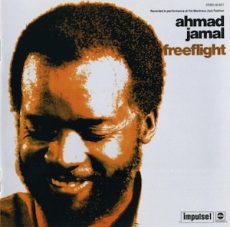
Requisites
Over the past fifty years, I’ve found immense joy in listening to Ahmad Jamal’s work across his extensive catalog, including releases on Argo, Cadet, and later Impulse Records. Each time I was fortunate enough to experience his trio live in Atlanta, their performance was absolutely electrifying. Jamal and his group consistently delivered music that was both profoundly moving and impeccably polished. Today’s featured album from my collection is Freeflight (Impulse! – ABC Records AS-9217), which showcases the trio’s live set at the Montreux Jazz Festival. On this recording, Ahmad Jamal plays both the Fender Rhodes electric piano and acoustic piano, joined by Jamil Nasser on bass and Frank Gant on drums. My personal copy is the 1973 U.S. stereo reissue, which retains the original catalog number.
The set opens with a warm welcome to the musicians, setting the stage for the trio’s spirited rendition of Effendi, by McCoy Tyner. The trio dives straight into the brisk tempo, with Ahmad igniting an energetic solo on the electric piano. There’s a brief exchange between Jamil’s bass and Ahmad’s acoustic piano before Jamal returns to the electric keys. Frank contributes a concise, lively reading, and Jamil finishes with an exhilarating finale, driving the tune to a thrilling close, earning an enthusiastic response from the audience. The tempo eases as Jamal introduces Dolphin Dance by Herbie Hancock on the acoustic piano, segueing into the group's melody. Jamal’s deeply expressive playing doesn’t disappoint, leading to a vibrant conclusion and audience applause.
Side Two begins with Ahmad and Jamil engaging in a musical conversation, leading into the pianist’s Manhattan Reflections. Jamal returns to the electric piano for a buoyant mid-tempo melody, then takes off first with a spirited opening statement that captures the energy of both instruments. The piano and bass then share the spotlight briefly to revisit the theme before the trio’s closing chorus ends gently. Ahmad returns to the acoustic piano to conclude the set with his signature tune, Poinciana by Nat Simon and Buddy Bernier. A solo introduction from Jamal leads into the ensemble’s mid-tempo theme. As the only soloist, Jamal tells a captivating story with Nasser and Gang’s support until the trio reunites to conclude the song, greeted by the audience’s enthusiastic applause!
The production of Freeflight was a collaborative effort between Ahmad Jamal and Ed Michel, while Carlos Olms and Stephan Sulke handled the recording of the live performance. Overall, the recording quality is commendable, though there’s one significant flaw: the microphone was positioned too close to Jamal’s electric piano during Effendi, resulting in noticeable harshness and overmodulation. However, please don’t let that minor drawback deter you from seeking out Freeflight by Ahmad Jamal when browsing for records on your next shopping trip. Although not as well- known as his earlier live release, At The Top: Poinciana Revisited, this album still deserves consideration for your library. Even after more than five decades, the album delivers outstanding piano trio music and is highly Recommended!
~ At The Top: Poinciana Revisited (Impulse! – ABC Records AS-9176) – Source: Discogs.com
~ Poinciana – Source: Wikipedia.org
© 2025 by Edward Thomas Carter
More Posts: choice,classic,collectible,collector,history,instrumental,jazz,music,piano
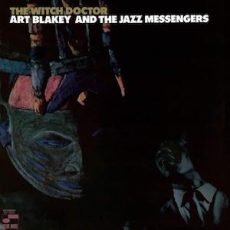
Requisites
The Witch Doctor ~ Art Blakey and The Jazz Messengers | By Eddie Carter
In this morning’s discussion, I’m excited to share a remarkable release from the library with you by Art Blakey and The Jazz Messengers. Although it was recorded back in 1961, The Witch Doctor (Blue Note BST 84258) didn’t become available to the public until 1967. The Jazz Messengers were renowned for their evolving roster of exceptional musicians, and this particular album features one of the drummer’s most memorable ensembles. The group consists of Lee Morgan on trumpet, Wayne Shorter on tenor saxophone, Bobby Timmons on piano, and Jymie Merritt on bass. The copy of this album I own is the 2021 Worldwide Blue Note Tone Poet Series stereo audiophile reissue, using the original catalog number.
The title tune by Lee Morgan opens the album, and the ensemble’s visit to The Witch Doctor sets a friendly tone with its mid-tempo introduction and inviting melody. Bobby starts us off with a relaxing solo, then Wayne takes a few easy-flowing choruses. Lee then takes over to give the following interpretation before Bobby returns to add a few comments, continuing to swing joyfully with the front line into the ending theme and climax. Lee’s Afrique begins with the trio’s animal sounds before Shorter’s piercing horn leads into the quintet’s medium-paced melody. Shorter kicks off the first solo with confidence, then Morgan adds an intense, steadily burning energy. Timmons approaches the third statement effortlessly, and Blakey finishes with a strong punch before the melody’s reprise and fadeout.
Wayne Shorter’s Those Who Sit and Wait grabs your attention right away with Art’s lively introduction to the quintet’s spirited theme. Wayne launches into a rapid-fire opening statement, followed by Lee’s energetic reading. Bobby jumps in next, meeting the challenge with an excellent solo that paves the way for a heated exchange between Lee, Wayne, and Art, propelling the ensemble to an electrifying climax. Side Two commences with the rhythm section’s infectious introduction, smoothly segueing into the group’s melody of Bobby Timmons’ A Little Busy. Timmons gets right to work first. Shorter keeps the lively mood going next, followed by another solo from the pianist. Lee paves a road back to the closing chorus, which softly fades away.
Joelle by Wayne Shorter comes at you with the rhythm section’s introduction gradually increasing into the ensemble’s upbeat theme. Lee makes the initial entrance with a nimble opening solo. Wayne delivers a captivating stream of ideas in the following reading. Bobby anchors the tune with a driving swing, culminating in a return to the melody that slowly dissolves into nothingness. Lost and Found by Clifford Jordan opens at a fast gallop for the quintet’s theme. Timmons leads the charge with a high-spirited statement, then steps aside for Shorter, who romps through the following solo. Morgan pours intense emotion into the third performance next, then Art engages the front line in a quick, dynamic exchange before the ensemble races to the conclusion with a sudden, abrupt stop.
The original recording session of “The Witch Doctor” was produced by Alfred Lion, with Rudy Van Gelder serving as the recording engineer. For the reissue, Joe Harley oversaw production, and Kevin Gray handled mastering, working directly from the original master tapes at Cohearant Audio. The result is exceptional audio quality, delivering a rich soundstage that truly immerses the listener. For those who are already collectors of the Blue Note Tone Poet Series, you know firsthand the exceptional quality and attention to detail these reissues offer, everything from high-resolution gatefold images and outstanding cover design to the premium 180-gram Virgin Vinyl, with the music itself being the ultimate highlight. But if you haven’t experienced them yet and you love jazz, you’re in for an absolute treat!
In addition to its outstanding musical performances, “The Witch Doctor” by Art Blakey and The Jazz Messengers is a fantastic album from beginning to end, perfectly embodying the essence of hard bop through vibrant compositions and dynamic group interplay. I highly recommend this Blue Note Tone Poet audiophile reissue as a great addition to your jazz library. I’m sure that whether you’re already a fan of Art Blakey or just starting to explore his extensive discography, this album is sure to become a favorite on your turntable!
© 2025 by Edward Thomas CarterMore Posts: choice,classic,collectible,collector,drums,history,instrumental,jazz,music
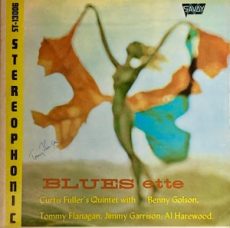
Requisites
Blues-ette ~ Curtis Fuller Quintet | By Eddie Carter
Curtis Fuller is widely regarded as one of the top jazz trombonists. A few nights ago, I enjoyed listening to this morning’s album from the library, and that’s what inspired this discussion of his 1959 release, Blues-ette (Savoy MG-12141/SST-13006). Throughout his more than 65 years in music, Fuller built an impressive catalog of recordings, both as a band leader and as a sideman, including work with Joe Henderson, Lee Morgan, Bud Powell, Wayne Shorter, Jimmy Smith, the Jazz Messengers, and the Jazztet. On this album, he’s joined by fellow Jazztet member Benny Golson on tenor saxophone, Tommy Flanagan on piano, Jimmy Garrison on bass, and Al Harewood on drums. The copy of this album I own is the 1973 U.S. stereo reissue, which shares the original catalog number.
Five Spot After Dark by Benny Golson opens the album. It’s a delightful medium-tempo tune that the front line brings to life with the melody. Curtis begins with a relaxing, welcoming solo. Benny blends each note of the following reading with a joyful energy. Tommy keeps the beat alive in the third interpretation. Jimmy joins the front line for the closing statement, leading to the ending theme and climax. Undecided by Sydney Robin and Charlie Shavers is a catchy tune that opens with the quintet laying down a gorgeous mid-tempo beat on the theme. Fuller takes center stage next with an impressive interpretation. Golson comes right behind him with an irresistible improvisation. Harewood provides a concise, impactful solo alongside both horns, building up to a lively reprise and a satisfying ending.
The title tune, Blues-ette by Curtis Fuller, wraps up the first side with Tommy’s sprightly introduction to the melody’s theme. Curtis sets the mood in the opening statement, delivering an understated and moving narrative. Benny effortlessly rises to the occasion in the following performance. Tommy follows with a dazzling display, then Jimmy caps the solos with a short walk to the ensemble’s close. Benny Golson’s Minor Vamp is anything but, as the second side unfolds, beginning with Garrison and Harewood’s introduction to the lively melody. Golson kicks off the solos, pouring his heart into each note. Fuller gives a captivating performance of lively verses next. Flanagan gets the last word with an energetic solo, ahead of the ensemble’s closing chorus and fadeout.
Love Your Spell Is Everywhere by Edmund Goulding and Elsie Janis begins with the quintet’s medium-tempo theme. Benny takes the lead with an exquisitely crafted performance. Next, Curtis gets into the groove with an exceptional reading that’s cool, smooth, and polished. Tommy executes the closing statement with meticulous execution ahead of the ensemble’s end theme and close. Garrison and Harewood open the door to the quintet’s easygoing unison melody to Curtis Fuller’s Twelve-Inch. Golson takes the stage first with a sweet and tasty reading. Fuller makes his case next with a captivating contribution. Flanagan moves sprightly along in the third solo, and Garrison puts the exclamation point on the song before the quintet comes back together to wrap things up.
“Blues-ette” was supervised by Oscar “Ozzie” Cadena, and Rudy Van Gelder managed the recording controls. The sound quality of this reissue is exemplary. The instruments deliver a vibrant soundstage that places the listener’s sweet spot in the studio with the musicians. If you’re a longtime fan of Curtis Fuller or are just discovering his discography, I invite you to check out “Blues-ette” on your next trip to your favorite record store. It’s a terrific album and is highly recommended for anyone’s library who enjoys hard-bop or lively “blowing sessions.”
~ Love Your Spell Is Everywhere – Source: Wikipedia.org © 2025 by Edward Thomas Carter
More Posts: choice,classic,collectible,collector,history,instrumental,jazz,music,trombone


